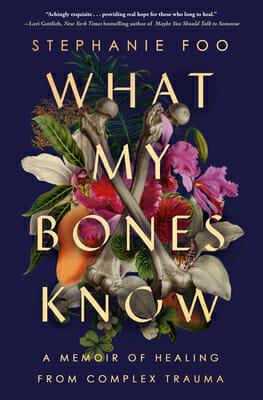If you asked me for the most impactful book I’ve ever read, I would probably say What My Bones Know. You should also know that I read a LOT (around 135 books a year). So when I say this was THE best book I read this year, that should mean something to you.
I recommend this book to anyone and everyone. I scream it to the rooftops. What My Bones Know is like a long therapy session you didn’t know you needed.
BUT YOU DO.
What My Bones Know is Stephanie Foo’s memoir on living with complex PTSD, a condition which wasn’t defined until only recently – and Foo has laid the roadmap for us.
PTSD happens when you live through a traumatic experience. Complex PTSD occurs when the trauma repeats again and again over the course of years. Until it becomes a part of who you are.
Foo says, “Every cell in my body is filled with the code of generations of trauma, of death, of birth, of migration, of history that I cannot understand. . . . I want to have words for what my bones know.”
Foo opens the book with a disclaimer: Part 1 is rough, and you can skip it if it’s too hard to read. She’s not joking. It made the Jennette McCurdy memoir, I’m Glad My Mom Died, look like a cakewalk. But it was also so, so important to read. So let’s dive in.
No child should go through this
Stephanie Foo grew up in San Jose, California as the only child of two Malaysian immigrants of Chinese descent. She oscillated between trying to please her emotionally unstable mother and avoidant father in a battle she did not understand she couldn’t win.
The abuse is shocking. From her mother beating her and berating her at knife point, to her father repeatedly threatening to kill them both in a car crash.
By the time she was a teenager, Foo had been completely abandoned in the house and was fending for herself. And somehow, through all of this, she picked up the pieces and became a successful radio journalist and producer of This American Life.
It seemed like Foo had her life together, but she couldn’t understand why so many things triggered her, why she never felt like she was good enough, and why she kept sabotaging her relationships.
Foo finally reached a breaking point and quit her job to focus on her mental health full-time. She acknowledges that she was very, very privileged to be able to do so.
Stephanie Foo’s What My Bones Know is written in five distinct parts, and all the abuse she lived through was only one of them. So you can see that her healing journey was a long and arduous one.
A long journey to healing
In her early 20s, Foo saw her first therapist. But it wasn’t until age 30 that she was diagnosed with C-PTSD. Her therapists failed her again and again because complex PTSD isn’t something they were trained on.
Finally, FINALLY, Foo met Dr. Ham, and received her official diagnosis. There was relief to finally have a name for her inner beast. And yet, she profoundly said: “Knowing that I am textbook doesn’t help me rise off the page.”
In truth, the real healing journey of What My Bones Know was just getting started. Foo interviewed neuroscientists and psychologists, practiced yoga, joined a support group for people who suffered childhood trauma, and tried many experimental therapies.
She even returned to her childhood home to “fact-check” her abuse.
But what helped the most was her work with Dr. Ham. He would record their therapy sessions and play them back to her so they could edit through the dialogue together line by line.
This work helped her see when her C-PTSD flared up, and when she disassociated – which she wasn’t aware she was doing.
She was able to finally gain insight into her mental and physical processes as a result of C-PTSD, and work through some of the trauma that was embedded in her bones.
“Trauma isn’t just the sadness that comes from being beaten, or neglected, or insulted. That’s just one layer of it. Trauma also is mourning the childhood you could have had. The childhood other kids around you had. The fact that you could have had a mom who hugged and kissed you when you skinned your knee. Or a dad who stayed and brought you a bouquet of flowers at your graduation. Trauma is mourning the fact that, as an adult, you have to parent yourself.”
A look at generational trauma
There is a famous study that was done on mice, where scientists exposed them to a chemical that smelled like cherry blossoms…and then shocked them. These mice began to associate the smell of cherry blossoms with fear and pain.
When the mice had babies, those babies were terrified of cherry blossoms, even though they had never been shocked. And the babies of those babies had panic responses to the smell of cherry blossoms too.
And this is how insidious trauma can be. If your grandparents lived through violence, went to jail, or fled a war-torn country – you could still be living their trauma.
In Stephanie Foo’s What My Bones Know, she acknowledges that her grandparents and great-grandparents had suffered what must have been immense trauma fleeing World War II and the Malayan Emergency.
She said, “My grandfather was imprisoned by the British during the Malayan Emergency for five years. And when he got out of prison, he lost all of his teeth somehow, and he never talked about it.”
And this is part of the problem. Particularly in Asian-American communities. No one talks about their trauma. People are expected to be quiet, to endure, and to constantly strive to be better. So no one gets help. And they feel isolated in their trauma.
If her parents inherited those traumas, and didn’t have people to raise them well due to the mental illnesses their own parents were suffering from, then it’s no wonder they weren’t able to cope well with raising children in a foreign country.
It’s incredible that Stephanie Foo was able to rise above it all and find the light at the end of a very long tunnel. And thanks to her incredible investigative journalism that chronicled her entire therapeutic journey, she’s made it possible for others to do the same.
What I Took Away From Stephanie Foo’s What My Bones Know

What My Bones Know is a remarkable piece of literature. Foo, as an investigative journalist, elevates what would have been a powerful memoir in its own right into something magical.
Her words are vulnerable, authentic, and empowering – making What My Bones Know the blueprint for how to write a memoir in my honest opinion.
But it’s not just the emotions Foo spills on the page that make this book so powerful. She did a heck of a lot of research, and that balance between emotion and rationality is what makes the words sing.
Foo makes no false promises. She knows that she will need to continue to grow and heal for the rest of her life. But for once she is finally thriving.
We leave her in a happy relationship, with a new-found family, and after the most beautiful and heartfelt wedding I’ve ever had the privilege to read about. One that made me want to go back in time and do my own wedding all over again (because clearly I did it wrong).
I’ve never read a book quite like What My Bones Know.
I sobbed tears of grief. I sobbed tears of joy. I SOBBED. This book broke me apart and put me back together again. And it’s something I will revisit again and again over the years.
I really and truly recommend What My Bones Know to anyone, but especially to Asian American immigrants – who will be able to relate to Foo’s story in a way I simply can’t. It’s also the perfect read for anyone who wants to learn how to write a self-help book. (You write it like this.)
But no matter who you are, or where you come from, there is wisdom to be gained here.
There is so much power between these pages.
Did you enjoy this review? Read other book reviews done by the selfpublishing.com team!

























